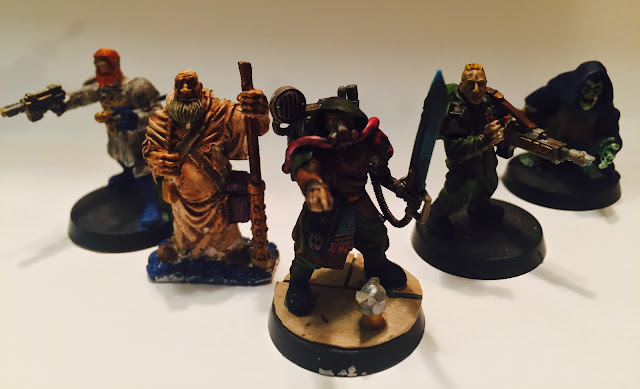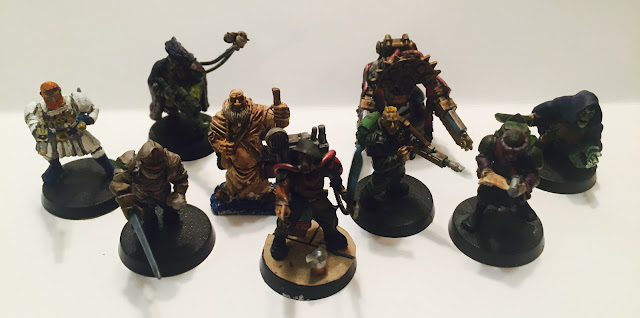Thanks
to all of you who have all ready purchased your copy of Men of Bronze
from Osprey Games. I appreciate your support and I look forward to
reading and hearing what you have to say about the game! I hope you
have as much fun playing it as I did making it!
Command,
Control,
and Morale has always been an element of wargames that has interested
me as a designer. These are two distinct concepts that
never-the-less work closely together. To me they are defined thus:
Command
and Control-
How
you give orders to your little plastic men, and how they respond to
these orders
Morale-
How
your little toy soldiers respond to the actions of the enemy toy
soldiers.
The
BIG QUESTION about these elements is how much player agency is
involved vs. how much friction should be created when dealing with
these two very important concepts? On one extreme, the player can
not dictate what their soldiers do, and instead the act and react
based on some sort of mechanic outside of the players ability to
influence it. On the other side is the player being able to have
their army men do exactly what they want them to do every time.
No
Control is represented by a mechanic like the following: Once a unit
reaches 50% casualties they are removed from the board. In this
case, the player can not stop or respond to a unit that reaches 50%
casualties. The unit is simply removed.
Exact
control is represented like the following: A unit is not routed until
it has reached 100% casualties and then removed from the board. In
essence, the toy soldiers will do whatever the commander wants until
it is completely annihilated.
The
wording in these two examples is the same except for the % of
casualties but you can see the result is completely different.
So,
the next thing to to think about is what exactly is “Friction” in
a wargame? I am no Von Clausewitz, but essentially friction is the
'difficulties' that a commander of little metal men needs to overcome
in order win the battle. Typically, friction is not necessarily
caused by the enemy but by all elements combined such as terrain,
objectives, your cat, unit fatigue, morale, etc. These frictions are
considered to compound as you are exposed to enemy actions, and
therefore make victory more difficult to achieve.
The
final interaction between Command, Control, Morale, and Friction is
what leads to the “depth” of a game. If the game provides
tactics and options to help a player minimize friction and morale
effects while providing options for Command and Control. The
decisions that the player makes in Command and Control can be used to
offset or reduce the worst effects of Morale and Friction.
As
a designer and a player, the question is how much of these extremes
do you want in your game and where does it meet somewhere in the
middle? It can be thought of as an equation.
Decisions+
(Command + Control) – (Morale and Friction) = Depth
That
was a long introduction to talk about how I went about trying to
tackle these issues in Menof Bronze.
Command
and Control
Leadership,
especially military leadership; was a topic of much discussion and
debate in the ancient world. The Greeks spilled much ink on the
topic, and many of their ideas are still relevant to our modern ideas
of what Leadership means. One of the key concepts was that of Arete.
What
the heck does that mean? Arete is the idea that a leader's purpose
was to raise up those he commanded to a higher morale purpose. He
was to act as an example to his soldiers and fellow citizens of what
is “correct” behavior. This can be seen in action many times
during Xenophon's Anabasis.
This
aspect of leadership is reflected in the rules in two major ways.
The first is the importance of using a unit leader to establish a
unit's movement, charges, line-of-sight, and flanking. The unit
leader moves, and then everyone moves to position themselves around
them. When combat occurs, the units rank up around their leaders.
The
second way is that each unit on the table is assumed to have a
leader. These leaders generate an Arete point that goes into the
armies pool. These points represent the individual unit leaders
inspiring, commanding, and organizing their troops in the field.
This field of points has a number of uses while in the game and
properly utilizing your Arete points will be a key element to
victory.
These
points are used to bid for initiative, try to interrupt your opponent
and gain initiative, provide dice re-rolls, trigger special
abilities, and declare charges. If you may not be able to complete
all of your objectives. Therefore, as the commander you need to
decide how you spend your Arete or command influence over your
troops. There will be times where you have more than you need, and
other times where you will not have enough.
All
movement distances and ranges for shooting are known. However, like
ancient commanders, there is no pre-measuring. Instead, you must
eyeball the distance and decide if your unit can hit the foe with a
javelin shot. Is the distance right for a charge? You decide, and
your soldiers will carry it out without question.
Finally,
as the player you can choose what units activate in what order.
However, a unit can only perform 1 action per activation. They can
move, shoot, fight, or charge. The player does not have unlimited
choice, instead the choices are limited and a decision must be made.
Is it better to shoot, move away, or charge an enemy? Once a unit is
engaged in combat, it will stay until a decision is met.
Morale
Morale
is a critical component of wargames. To me, it is one of the 4Ms
which
are the core building blocks of any wargame. As I define Morale it
is how our models react to the actions of enemy models. In the case
of Men of Bronze,
enemy actions that can cause morale related reactions is being shot
and fighting.
All
Units have a Courage stat that is depleted by combat actions. Units
that take Courage loss will have to take a Morale test or begin to
waver. Once a unit reaches a certain level of Courage, they will
change to wavering status automatically. This impacts their target
numbers for combat rolls. Once their Courage is reduced to 0, they
are turned around and eventually removed from the board as routing.
However,
this will trigger a Collapse Test. All units that have leaders that
can see the turned unit will have to also take a discipline test. As
more Collapse tests are taken the likelihood of failing increases.
If failed, the watching units will start to waver or rout as well.
Like ancient battles, armies can disappear quickly as their nerve
collapses. Leaving those that remain in a difficult position and
forcing more friction on you as the player.
The
final morale related component is the “push back” mechanic.
Units that lose more Courage than they inflict will be pushed back
1d3 base widths at the end of the turn. Therefore, enemy units can
be pushed off objectives, out of terrain, etc. In addition, this
feature can force units to “join” a combat that may not have
initially been engaged.
Conclusion
Therefore,
as a designer my preferences are clear. On the continuum of Exact
vs. No Control I like to mix it up with a leaning to less control as
friction mounts. When Unit's reach certain points their ability to
perform as expected will be degraded, they will still carry-out what
you want them to do; but at a lesser efficiency. If they degrade too
far, they are no longer in your control. This causes additional
follow-on effects that may reduce your control further in a cascade
of “friction”.
However,
players have complete control over how and when they use their Arete
points to influence the battle and your soldiers always use these
points as intended. If you want them to charge, they will charge.
Change formation, then they will change. Move and shoot, they will
do it. There are no random charge distances or ranges, they are all
set and known. The decision is yours for your men to carry-out.
I
prefer a game that generates mounting friction for you as a commander
that forces you to make choices. Often, the commander who faces the
most “friction” is the one who will lose, but successful
commanders find a way to overcome such “friction” through
tactics. That is where a games “depth” comes from.
Hopefully,
I have found the right combination of Command, Control, Morale,
Friction, and decision making to create the right level of depth for
you in Men ofBronze.
There is only one way to find out!





























